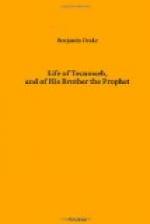Of the result of the mission of Tecumseh to the southern tribes, we have no detailed information. Hodgson, who subsequently travelled through this country, in his “Letters from North America,” says:
“Our host told me that he was living with his Indian wife among the Creeks, when the celebrated Indian warrior Tecumseh, came more than one thousand miles, from the borders of Canada, to induce the lower Creeks, to promise to take up the hatchet in behalf of the British, against the Americans, and the upper Creeks whenever he should require it: that he was present at the midnight convocation of the chiefs, which was held on that occasion, and which terminated after a most impressive speech from Tecumseh with a unanimous determination to take up the hatchet whenever he should call upon them. This was at least a year before the declaration of the last war.”
In the “History of the Tribes of North America,” there is an interesting notice of this visit of Tecumseh.
“The following remarkable circumstance may serve to illustrate the penetration, decision and boldness of this warrior chief. He had been south, to Florida, and succeeded in instigating the Seminoles in particular, and portions of other tribes, to unite in the war on the side of the British. He gave out that a vessel, on a certain day, commanded by red-coats, would be off Florida, filled with guns and ammunition, and supplies for the use of the Indians. That no mistake might happen in regard to the day on which the Indians were to strike, he prepared bundles of sticks, each bundle containing the number of sticks corresponding to the number of days that were to intervene between the day on which they were received, and the day of the general onset. The Indian practice is to throw away a stick every morning; they make, therefore, no mistake in the time. These sticks Tecumseh caused to be painted red. It was from this circumstance that in the former Seminole war, these Indians were called ‘Red Sticks.’ In all this business of mustering the tribes, he used




